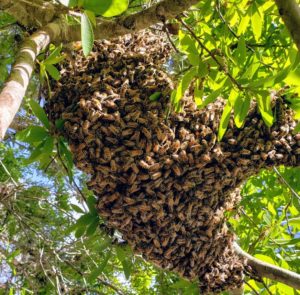
A few weeks ago, we had the opportunity and blessing to capture a swarm of bees. My spousal unit (Pam) was tending to some plants in the front yard and heard bees buzzing – lots of bees. Looking around she noticed many bees flying about the tree in our front yard. She asked me to come take a look and sure enough there was a swarm of bees on a branch.
When bees swarm, it is a colony of bees relocating, led by a queen. In this state, they are not aggressive and usually will not sting you if you leave them alone. This is because they have no brood (bee larvae) or honey to protect. Their main goal is to find a new home, because the old one is too small. A small number of bees will remain in the old home and create a new queen. The creation of the new queen is a fascinating process, but we’ll talk about that another time.
Because capturing a swarm is like “free bees”, I grabbed a nuc box out of the shed and put 3 frames in it. The nuc box is like a temporary hive and is used by beekeepers when they are increasing their hives. It is the “nucleus” of a new hive. The nuc holds 5 frames (what the bees walk around on and build their comb on), while a regular hive box holds either 8 or 10 frames. I suited up with the bee veil and a pair of gloves. I held the Nuc Box under the swarm and Pam shook the branch. The bees fell into the box — not all of them, but most of them. We placed the nuc box on the ground and within an hour, we knew the queen was in the box because all the bees had followed her in. It is something to see them pouring into the box where their queen is!
For a couple of days, the bees stayed in the nuc while I got a hive box and frames ready for our newbees (pun intended). At this point I suited up completely – bee veil, bee suit, and gloves, and transferred the bees into the new hive box where they are today. Our new hive appears to be doing well and is already generating brood (larva) and honey.
The good fortune of successfully capturing this swarm has me determined to be more proactive about keeping bees, rather than just having bees, and I’ve instituted a regular inspection schedule.
Our original hive has been doing well, and has plenty of brood, and the super (additional boxes added to the top of a hive to allow it to expand) had some frames of honey. The other two hives, growing out from nucs obtained in the fall, are doing well. Recently, I’ve added supers to each of those hives.
Because I was eager to harvest some of the honey I saw in the original hive, I borrowed a honey extractor from the Lake County Bee Club. The extractor spins the frames so that centrifugal force causes the honey to fling out and be collected in the bottom.
Honey is contained in comb, where each individual “cell” is sealed with wax. I used a tool to rake these seals off the comb so the honey could be extracted. Using the extractor allows as much of the comb as possible to be recycled. Because it takes the bees six times as much work to make wax as honey, this recycling is very important for the health of the colony. I extracted only three frames and harvested nearly a gallon of honey. Pam filtered the honey to remove bee parts and bits of wax. The wax and “caps” were saved; Pam has rendered the wax and will use it in her soaps.
This honey is probably orange blossom honey, since that is what is blooming. It is a beautiful gold color in the jars and is quite tasty!
I’m looking forward to working with the bees and continuing our journey together.
